|
Real Science with SBIG ST-7 and ST-9 CCD camera:
Back
to Advanced Topics

Memo
The Capabilities of the ST-7XEI and ST-9XEI Series Cameras
Alan Holmes
12/16/2003
SBIG has recently announced new low prices for USB based ST-7XEI
and ST-9XEI cameras. Our intent here is to make quality, scientific grade
sensors available at minimal cost. Before in an application note I discussed the
importance of self guiding, but I have since realized that several types of
observations, mostly neglected by amateurs, do not require critical guiding. The
beauty of these types of observations is that not only can the CCD camera be
less expensive, but also the telescope. These days telescopes of substantial
aperture are really quite inexpensive, but a good, high quality mount is not. In
this memo I discuss these types of observations, and show some results I have
obtained from my backyard sea level site, where the Milky Way is just barely
detectable on a good night. You will be amazed at what is possible!
TDI Techniques – Turn off the Guiding!
Professional astronomers performing sky surveys or asteroid
searches often build instruments that employ time delay integration (TDI) with a
CCD. This powerful technique is not only gives good results, but it can be done
with a very simple telescope system. In essence, the telescope is fixed, and as
the stars drift across the CCD the CCD is clocked at exactly the right rate to
keep the accumulating charge underneath the star’s image until the star reaches
the edge of the CCD, and the readout register. An SBIG user, Christoph Flohr,
has written a very capable program for doing this kind of imaging with SBIG
cameras, particularly the ST-7/8/9/10 series. The program can be downloaded for
free from www.driftscan.com.
Figure One shows a large mosaic image to illustrate this
technique. The data was captured from my suburban back yard here in Santa
Barbara. I used an ST-7XEI, uncooled, on an 8 inch F/4 Newtonian tube assembly I
bought from Hardin Optical for $300. The mount was a Losmandy G11. Data is
collected with the mount turned off. I would find the starting point with the
drive running, turn off the mount right when I started collecting the data, and
26 minutes later increment the declination position manually by 0.33 degree and
shift the telescope by 30 minutes (to an earlier setting) in right ascension. At
the 30 minute mark I would start the next 26 minute swipe. I collected 9 swipes,
each with 765 x 7500 pixels of data, in each data set. I had to do this over two
nights. The data was assembled in Photoshop and cropped and manually touched up
to get rid of the diffraction spikes and “tails”. When a bright star passes over
the CCD it leaves a little residual charge that leaks out over the next few
seconds, leaving a tail. If I cooled the CCD the tail would be less prominent,
but also longer. I didn’t cool the CCD just to prove a point with others here at
SBIG that it is less important with TDI imaging, since the hot pixels are
averaged over the entire height of the CCD. The Kodak full frame devices are
quite low in dark current. I used a red filter over the CCD to reduce my
considerable light pollution. The final cropped imaged shown was assembled from
45 megapixels of data!
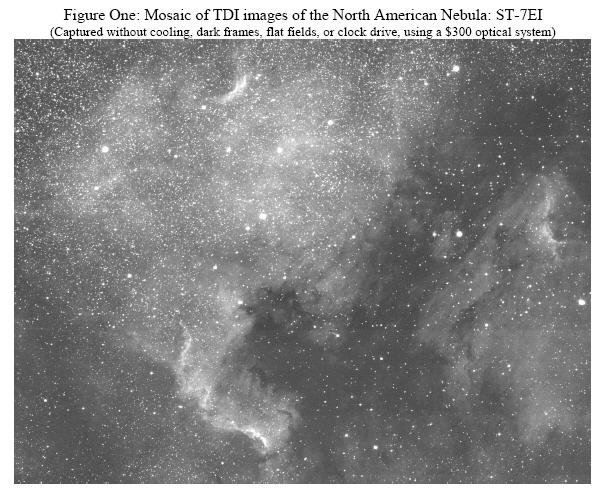
One has to accurately align the columns of the
CCD with the drift of the star to get good star images. I would drive the system
back in forth in RA while taking a 10 second exposure, and then tweak the camera
rotation to get vertically streaked stars to within a pixel. I rotated the
camera by loosening the setscrew, rotating the camera, and retightening the
screw – nothing fancy. This task is comparable in difficulty to focusing the
camera. If one has an equatorial mount, you only have to do this alignment once.
SBIG now has a precision camera rotator to facilitate this task.
With my telescope and CCD, the drift time for a
star to cross the CCD was about 120 seconds. When one is not on the celestial
equator, the stars follow a curved path, and you can get some elongation at the
edges of the field of view. At the 45 degree declination of the North American
Nebula this effect is a few pixels at the edges.
The choice of a telescope is actually a
complicated tradeoff. In Table One below I have tabulated the resolution,
elevation field of view, maximum exposure time at the celestial equator,
limiting magnitude, and image smear at +/- 60 degrees declination due to the TDI
drift rate varying with declination angle. An F/4 optical system is assumed.
Longer focal lengths have better resolution and less image smear, but at the
expense of field of view. Note that since longer focal lengths result in shorter
exposure times, sensitivity to starlight only increase linearly with aperture.
The volume and cost of the optics and mechanics tend to scale with the cube of
the aperture, though, compelling one to favor shorter focal lengths. However,
short focal lengths will have more elongation due to differential velocity at
the edges of the field of view. This effect varies as the tangent of the
declination being viewed, so it will be only 58% of the tabulated value at 45
degrees declination. The 8 inch F/4 Newtonian is a good choice with an ST-7XEI.
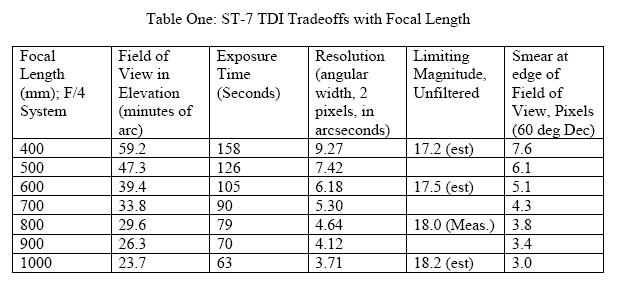
With my images, the lack of cooling caused the
hot pixels to form hot streaks in the image. SBIG has a utility in CCDOPS,
called FIX UNCOOLED TDI IMAGE, that corrects this line-to-line offset nicely. I
also had one image that showed a 30 count variation in sky brightness from side
to side (I have no idea why, the images before and after were fine). Matt
Longmire added another utility to CCDOPS that adds a wedge to one’s image data
to flatten this out.
In Figure Two I show an image of M65 and M66
captured using a Celestron 8 inch SCT. I used our FR-4 focal reducer to get the
F/number down to around F/5 for a wider field of view. It is amazing how much
detail can be captured in a single 56 second pass of the scene across the CCD.

I encourage everyone to experiment with this technique. I hope
my example of what can be done with no cooling, no clock drive, no dark
subtraction, no flat field, and a very modest optical system encourages others
to try this out! The technique is great for huge mosaics, asteroid hunting, and
for users with inexpensive mounts. The ST-9EI is even better for this technique,
since the larger device results in longer transit times across the CCD,
increasing the exposure. Below I show an ST-9EI strip captured showing NGC7331.
Huge portions of the sky can be imaged! The small scale below simply does not do
the image justice.
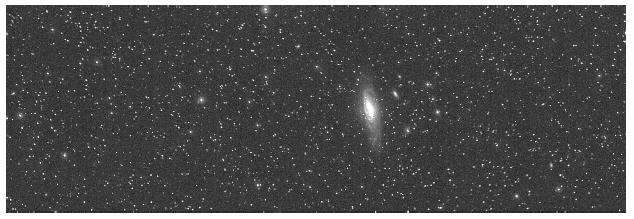
Real Science: Exo-Solar Planet Detection
from your BackYard!
Another field of study where accurate guiding is
not that important is photometry. This may come as a shock to some, but for
photometry of brighter objects a little wander of the star image is a good
thing, as it averages out sub-pixel, and pixel-to-pixel variations that would
otherwise limit the data accuracy. Also, for brighter objects short exposures
are desired since otherwise the stars saturate, and data accuracy is degraded.
Brighter is a relative term here. CCD cameras have such great sensitivity that
exposures of only 30 seconds are adequate for stars down to 14 th
or 15th magnitude with an 8
inch scope. As a result, many objects can be studied by taking a long series of
unguided (but with a clock drive running) 10 to 30 second exposures. Guiding is
used to bring the star back to the starting point occasionally, but the guide
information is derived from the image data from the imaging CCD. Guide stars are
very easy to find under these conditions. What can you do with bright star
photometry? You can find planets around distant stars!
Detecting Extra-Solar Planets by Timing
Eclipsing Binaries
Laurance Doyle (SETI Institute) has pioneered a
new technique for detecting planets around eclipsing binaries. An eclipsing
binary is a pair of stars orbiting each other so closely that their atmospheres
are in contact, and have periods ranging from a few hours to a day or two. The
timing of mid-eclipse can be measured to a matter of a few seconds. If a planet
is orbiting the combined system it will shift the center of mass of the binaries
back and forth as it orbits, and the additional light travel time can be
measured. What one will see after years of measurement is a cyclically varying
variation in the time of mid eclipse. The technique is quite sensitive, and has
the potential to detect earth-sized planets. However, one does not have to spend
years observing the star since the individual cycles are only a matter of hours,
and observations from multiple amateurs are easily coordinated if all have
accurate timing. Russell Genet is quite active in measuring eclipsing binaries,
and is eager to coordinate the activities of individual amateurs. He can be
reached at
russmgenet@aol.com.
Russell is well known due to his book on Microprocessor Control of Small
Telescopes.
To illustrate this technique I used an ST-7XEI to
monitor CY Aquarii one night for a few hours, once again with my $300 8 inch F/4
Newtonian. I love it – I think its Chinese made, but the quality is good, the
optics are fine and the steel tube means I didn’t have to refocus for a month. I
used a G11 mount from Losmandy, which has also given me years of good
performance. Below I show the star field including CY AQR. It is the brightest
star near the upper right edge in this 15 second exposure.
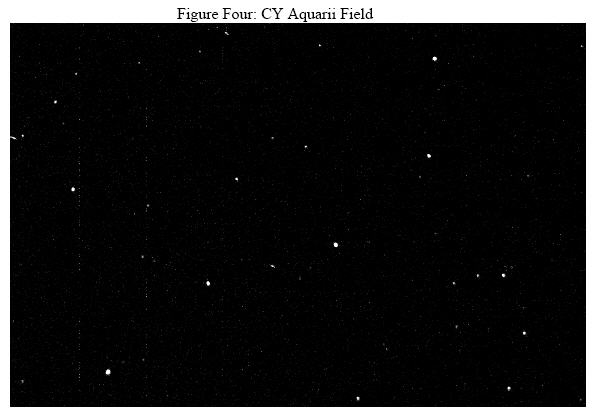
Figure Five shows the brightness fluctuations of this star. It
varies by 70% every 88 minutes, which is very fast. I captured three cycles in
one evening by midnight. While it is not an eclipsing binary, it makes my point
that there are objects in the sky that vary quite fast. This star increases 30%
in brightness in only 4 minutes right before maximum. You can see it changing on
the computer screen. At minimum it is around magnitude 11.2. Also, you don’t
need photometric filters. I used a red filter to minimize light pollution and
atmospheric variation as the star rose in the sky, but what is really important
here are the times of minima, and the period. This is a relative measurement,
derived by comparing the star brightness with nearby stars. The data shown is
derived from 800 frames captured automatically by MilliMag, a new SBIG program
that makes this type of data collection very easy. It will be described further
on our web site when it becomes available.
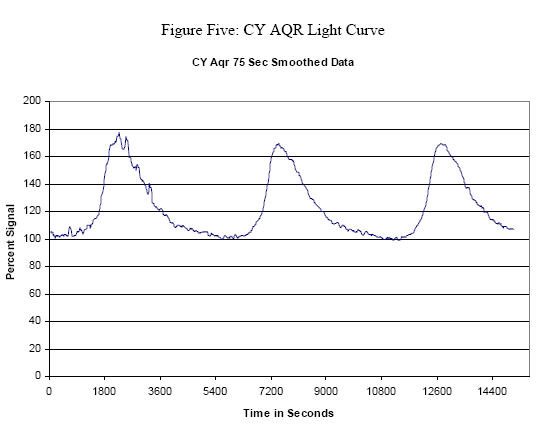
Detecting Extra-Solar Planets by
Observing a Transit
Tim Castellano of NASA-AMES is seeking amateur
participation in a project to detect planets orbiting other stars by looking for
the reduction of the star’s brightness when the planet passes in front of the
star. So far I know of 4 separate groups of amateurs who have successfully
measured the 1.7% drop in brightness of HD209458 using commonly available
equipment (including me). Other stars are suspected of harboring planets
based on radial velocity measurements but no other eclipsing planets have yet
been detected. SBIG’s MilliMag software simplifies and automates this
photometric measurement specifically for the ST-7XEI or ST-9XEI, achieving a
relative brightness measurement accuracy of 2 millimagnitudes per 5 minute
interval with an 8 inch F/4 scope. For more information please visit
www.transitsearch.org,
or contact Tim (tcastellano@mail.arc.nasa.gov).
My measurement of this object is illustrative of
what can be achieved. The star field including HD209458 is shown below in Figure
Six. Once again, an unremarkable star, below the center (the brightest one), is
the one most conclusively proven to show planet transits in the sky.
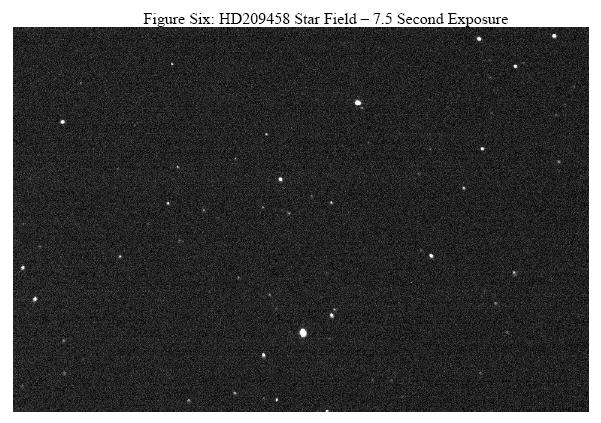
I was able to capture the beginning of a transit as the planet
starts to partially block the starlight, as shown below in Figure Seven. The
noise in this type of observation is mostly due to the twinkling of starlight,
still an effect even with an 8 inch aperture. Averaging over a minute’s worth of
observations helps. Over 1000 frames of data were collected for this graph. The
total obscuration is only 1.7%, so this is a tough observation.

There is a common thread to the photometric
research opportunities detailed above. All involve sitting on an object for
hours with a telescope looking for a brightness change. This type of research is
very difficult for the major observatories, since it ties up so much equipment
and staff, night after night. It is also difficult for NASA, for the same
reasons.
Another common thread to these opportunities is
that in all cases the events that are being monitored are only hours long. In
the case of transits and eclipsing binaries, the stars are bright, and location
and detection of the object is easy with an 8 inch (20 cm) telescope. One does
not need long spells of clear weather to gather useful data. Also, our free
MilliMag program does most of the data analysis for you!
In this day and age, when automated professional
instruments are sweeping up asteroids, and checking thousands of galaxies for
supernovae every night, it is heartening to find that there are still arenas
where the amateur can contribute. These opportunities summarized here are also
easiest for the amateur since his equipment can run with little attention.
Finding planets around other star systems! This is significant research! Five
years ago humans speculated whether or not there were planets around other star
systems, and now amateurs with a $1000 telescope and a $1495 CCD camera can
prove that there are!
Many other photometric observation opportunities
can be pursued with an ST-7XEI or ST-9XEI. An interesting one is measuring
asteroid rotation rates. Brian Warner ( www.MinorPlanetObserver.com)
and Robert Stephens have spearheaded amateur involvement in determining rotation
rates of asteroids based on measurements of their brightness as they tumble. The
rotation rate is quite often only a few hours, enabling an amateur to get a
preliminary determination in a single night. Follow up observations can pin down
the rotation rate to high accuracy, and measurements of the asteroid over a
period of time can reveal the orientation of its rotation axis as the
earth-sun-asteroid geometry changes. Once again, this is a straightforward
relative measurement not requiring photometric filters or a sophisticated setup.
For more information please contact Brian (brian@MinorPlanetObserver.com).
Brian has also written an excellent amateur oriented book describing light curve
collect and analysis in general, entitled A Practical Guide to Lightcurve
Photometry and Analysis. It details both stellar and asteroid photometry.
SBIG also recommends the interested amateur check
out the American Association of Variable Star Observers (AAVSO) web site, as
they also welcome new observers. As one of the oldest amateur-professional
collaborations around, they have a well developed program to monitor variable
stars of all types around the world. They are an excellent source for locator
maps and known target stars for verifying one’s technique. Their web site can be
found at
www.aavso.org.
Of Course, One can also Image the Sky!
This discussion so far has ignored the most
obvious use of our cameras, taking images of the night sky. The ST-7EI and
ST-9EI will work quite well for that, even with short exposures. As an example,
I have some more 8 inch scope images using an ST-7XEI. Figure Eight shows a 10
second image of M13. Figure Nine shows a 4x30 second track and accumulate image
of M101. Compare to this to what you see through the eyepiece!

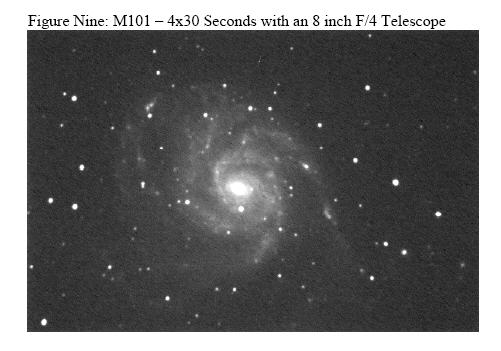
Back to Top |
Back
to Advanced Topics |

